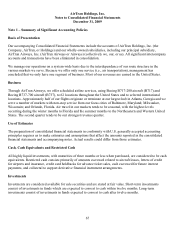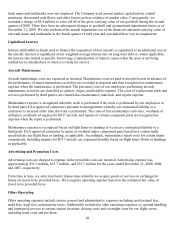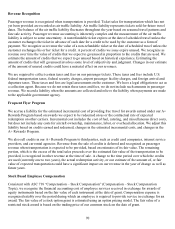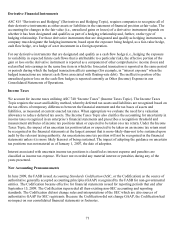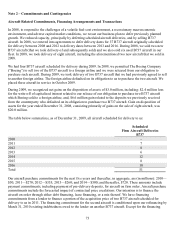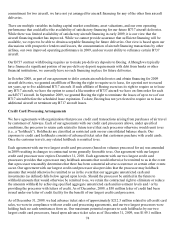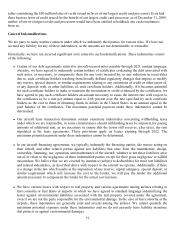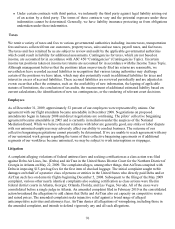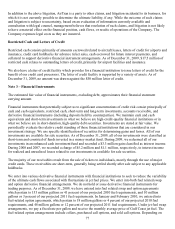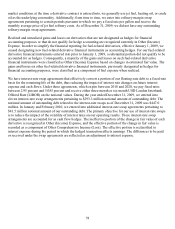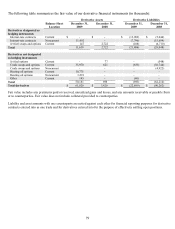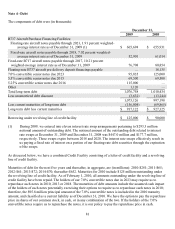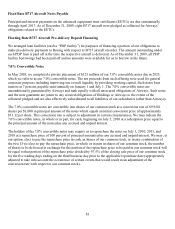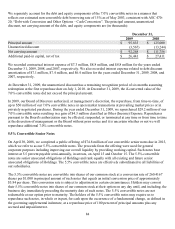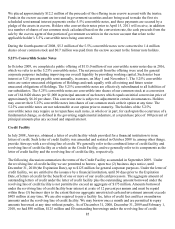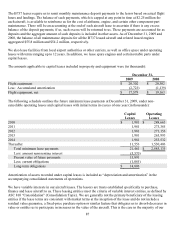Airtran 2009 Annual Report Download - page 86
Download and view the complete annual report
Please find page 86 of the 2009 Airtran annual report below. You can navigate through the pages in the report by either clicking on the pages listed below, or by using the keyword search tool below to find specific information within the annual report.77
In addition to the above litigation, AirTran is a party to other claims, and litigation incidental to its business, for
which it is not currently possible to determine the ultimate liability, if any. While the outcome of such claims
and litigation is subject to uncertainty, based on an evaluation of information currently available and
consultation with legal counsel, management believes that resolution of such claims, and litigation is not likely
to have a material effect on the financial position, cash flows, or results of operations of the Company. The
Company expenses legal costs as they are incurred.
Restricted Cash and Letters of Credit
Restricted cash consists primarily of amounts escrowed related to aircraft leases, letters of credit for airports and
insurance, credit card holdbacks for advance ticket sales, cash escrowed for future interest payments, and
collateral to support derivative financial instrument arrangements. As of December 31, 2009, $17.5 million of
restricted cash relates to outstanding letters of credit, primarily for airport facilities and insurance.
We also have a letter of credit facility which provides for a financial institution to issue letters of credit for the
benefit of our credit card processors. The letter of credit facility is supported by a variety of assets. As of
December 31, 2009, no amount was drawn against the $50 million letter of credit.
Note 3 – Financial Instruments
The estimated fair value of financial instruments, excluding debt, approximates their financial statement
carrying amount.
Financial instruments that potentially subject us to significant concentrations of credit risk consist principally of
cash and cash equivalents, restricted cash, short-term and long-term investments, accounts receivable, and
derivative financial instruments (including deposits held by counterparties). We maintain cash and cash
equivalents and short-term investments in what we believe are high-credit-quality financial institutions or in
what we believe are in short-duration, high-quality debt securities. Investments are stated at fair value. We
periodically evaluate the relative credit standing of those financial institutions that are considered in our
investment strategy. We use specific identification of securities for determining gains and losses. All of our
investments are available for sale securities. As of December 31, 2009, all of our investments were classified as
short-term and consisted of funds invested in a money market fund. During 2009, we redeemed all of our
investments in an enhanced cash investment fund and recorded a $3.3 million gain classified as interest income.
During 2008 and 2007, we recorded a charge of $5.2 million and $1.1 million, respectively, to interest income
for realized and unrealized losses related to our investments in available for sale securities.
The majority of our receivables result from the sale of tickets to individuals, mostly through the use of major
credit cards. These receivables are short-term, generally being settled shortly after sale subject to any applicable
holdbacks.
We enter into various derivative financial instruments with financial institutions to seek to reduce the variability
of the ultimate cash flows associated with fluctuations in jet fuel prices. We enter into both fuel related swap
and option derivative financial arrangements. We do not hold or issue derivative financial instruments for
trading purposes. As of December 31, 2009, we have entered into fuel related swap and option agreements
which pertain to 153 million gallons or 41 percent of our projected 2010 fuel requirements, and 10 million
gallons or 3 percent of our projected 2011 fuel requirements. In January and February 2010, we entered into
fuel-related option agreements, which pertain to 18 million gallons or 4 percent of our projected 2010 fuel
requirements, and 48 million gallons or 12 percent of our projected 2011 fuel requirements. Under jet fuel swap
arrangements, we pay a fixed rate per gallon and receive the monthly average price of Gulf Coast jet fuel. The
fuel-related option arrangements include collars, purchased call options, and sold call options. Depending on


